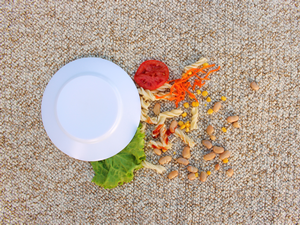Cooking grease is easily and invisibly tracked through the home from the kitchen and onto carpets by people and pets—and cannot be vacuumed away. Here are a few tips for limiting and eliminating grease.
Prevention: Modify Cooking Methods
Try increasing your use of alternatives to frying, such as boiling, broiling, crock pot, or other cooking methods. When you do fry, use a splatter guard or lid on your pan, lower your cooking temperature, and use high-temperature-friendly oils or fats.
Removing a Grease Spot on Carpet
If you have a grease spot from a spill, you may be able to clean it using DIY methods. First, remove any excess grease using paper towels, and if necessary, the flat edge of a dull knife. Sprinkle some baking soda on the grease and allow it to remain for an hour or longer. The baking soda will absorb excess grease. Vacuum the baking soda off the carpet. Mix mild, bleach-free, alkali-free detergent and warm water. Use two clean, absorbant, white rags, one to apply the detergent, and the other to absorb the detergent. Blot the spot, and do not rub it. Rubbing will only spread the grease to clean carpet fibers. Repeat this process until the spot is removed. For stubborn grease spots, use a dry cleaning solvent or a protein enzyme like laundry detergent or OxiClean.
Professional Carpet Cleaning Removes Grease
If you have a thin layer of grease over a wide area of carpet, or if your DIY spot removal methods failed, then it is time to contact your professional carpet cleaner. Professional carpet cleaning solutions and equipment achieve a deep level of clean not possible with regular vacuuming, spot removal methods, or using a rented carpet cleaning machine. If you do not have a professional carpet cleaner, contact us. We will safely and effectively get the grease out and leave your carpets clean and fresh.
This is one of a series of articles written and published on behalf of Surface Care PRO Partners.

